Laura Perry's Blog, page 13
August 31, 2016
Let's Celebrate the Feast of Grapes!
 In Modern Minoan Paganism, the last day of August is the Feast of Grapes. It's a celebration of the grape harvest and the sacrificial death of the vine-god Dionysus. Find out how you can mark this day in today's Minoan Path blog post:Let's Celebrate the Feast of Grapes!To join the conversation about Modern Minoan Paganism, head on over toAriadne's Tribe, our welcoming community on Facebook.In the name of the bee,And of the butterfly,And of the breeze, amen!
In Modern Minoan Paganism, the last day of August is the Feast of Grapes. It's a celebration of the grape harvest and the sacrificial death of the vine-god Dionysus. Find out how you can mark this day in today's Minoan Path blog post:Let's Celebrate the Feast of Grapes!To join the conversation about Modern Minoan Paganism, head on over toAriadne's Tribe, our welcoming community on Facebook.In the name of the bee,And of the butterfly,And of the breeze, amen!
Published on August 31, 2016 05:40
August 24, 2016
Book Review: The Old Ones in the Old Book
 I recently had the pleasure of reading a really unique book. For years I've been fascinated by the tidbits about ancient pagan spiritual practice that are scattered throughout the Bible's Old Testament, a.k.a. the Tanakh. But I was never able to put those bits together into a cohesive picture of what that spirituality might have looked like. Then I readThe Old Ones in the Old Bookby Philip West. And it turns out, the world of the Old Testament wasn't nearly as monotheistic as many people would like us to believe.West is a biblical scholar but the book isn't at all stuffy. In fact, it's fascinating. He begins by explaining what the Old Testament is - who wrote its parts as well as how, why, and when it was all put together. I had read some of this information before but West puts it all together in a way that gives context to the literature. In other words, now I understand where it all came from.West then goes on to explain not just the pagan references in the Bible but the culture and history that those practices came from. His fascinating, detailed explanations fall into six categories, each one with its own chapter: The Religion of the Patriarchs; Yahweh, Mount Sinai and Moses; Religion in Canaan before King David; Jersualem, King and Temple; Divided Kingdoms and Hebrew Goddesses; and By the Waters of Babylon.The way West organizes the chapters helps to make the information clear and understandable. Instead of an examination of the books of the Old Testament one by one, he follows the threads of the narrative that tells the story of the Hebrew people. So in addition to discovering all sorts of fascinating information about the polytheistic culture of that time and region, I also developed a much better understanding of the whole Old Testament story arc. The linguist in me also appreciates that West does his own translations of pertinent Bible passages and explains the way the Hebrew words work so I'm clear on exactly what was written and what it means.He finishes up the book with a chapter about polytheism versus monotheism, falling squarely on the side of polytheism. I expected to glide through that chapter with a preaching-to-the-choir attitude, but he brought up some issues I really hadn't thought about in terms of the flexibility and helpfulness of the different worldviews for making the world a better place. So even that bit added to my reading experience.In the West, we're eyeball-deep in a culture that's permeated by Biblical concepts. Even if we don't follow any of the Abrahamic paths, we can't avoid coming into contact with the stories and ideas from the Bible. This book helps to put them in context and helps to clear up some misconceptions about what the tales really say. And what they say is that the Old Ones - the gods and goddesses of Mesopotamia and the Levant - had a much bigger part to play in the Bible than most people realize.
I recently had the pleasure of reading a really unique book. For years I've been fascinated by the tidbits about ancient pagan spiritual practice that are scattered throughout the Bible's Old Testament, a.k.a. the Tanakh. But I was never able to put those bits together into a cohesive picture of what that spirituality might have looked like. Then I readThe Old Ones in the Old Bookby Philip West. And it turns out, the world of the Old Testament wasn't nearly as monotheistic as many people would like us to believe.West is a biblical scholar but the book isn't at all stuffy. In fact, it's fascinating. He begins by explaining what the Old Testament is - who wrote its parts as well as how, why, and when it was all put together. I had read some of this information before but West puts it all together in a way that gives context to the literature. In other words, now I understand where it all came from.West then goes on to explain not just the pagan references in the Bible but the culture and history that those practices came from. His fascinating, detailed explanations fall into six categories, each one with its own chapter: The Religion of the Patriarchs; Yahweh, Mount Sinai and Moses; Religion in Canaan before King David; Jersualem, King and Temple; Divided Kingdoms and Hebrew Goddesses; and By the Waters of Babylon.The way West organizes the chapters helps to make the information clear and understandable. Instead of an examination of the books of the Old Testament one by one, he follows the threads of the narrative that tells the story of the Hebrew people. So in addition to discovering all sorts of fascinating information about the polytheistic culture of that time and region, I also developed a much better understanding of the whole Old Testament story arc. The linguist in me also appreciates that West does his own translations of pertinent Bible passages and explains the way the Hebrew words work so I'm clear on exactly what was written and what it means.He finishes up the book with a chapter about polytheism versus monotheism, falling squarely on the side of polytheism. I expected to glide through that chapter with a preaching-to-the-choir attitude, but he brought up some issues I really hadn't thought about in terms of the flexibility and helpfulness of the different worldviews for making the world a better place. So even that bit added to my reading experience.In the West, we're eyeball-deep in a culture that's permeated by Biblical concepts. Even if we don't follow any of the Abrahamic paths, we can't avoid coming into contact with the stories and ideas from the Bible. This book helps to put them in context and helps to clear up some misconceptions about what the tales really say. And what they say is that the Old Ones - the gods and goddesses of Mesopotamia and the Levant - had a much bigger part to play in the Bible than most people realize.
Published on August 24, 2016 05:39
August 17, 2016
How do you do Minoan?
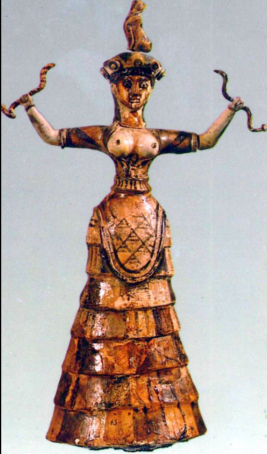 The most common question people ask me is, "How do you DO Modern Minoan Paganism?" In other words, what does the spiritual practice look like? I've answered that question in today's blog post over at The Minoan Path on PaganSquare:How do you do Minoan?If you'd like to join the conversation about Modern Minoan Paganism, head on over to our welcoming community atAriadne's Tribeon Facebook.In the name of the bee,And of the butterfly,And of the breeze, amen.
The most common question people ask me is, "How do you DO Modern Minoan Paganism?" In other words, what does the spiritual practice look like? I've answered that question in today's blog post over at The Minoan Path on PaganSquare:How do you do Minoan?If you'd like to join the conversation about Modern Minoan Paganism, head on over to our welcoming community atAriadne's Tribeon Facebook.In the name of the bee,And of the butterfly,And of the breeze, amen.
Published on August 17, 2016 05:09
August 10, 2016
Book Review: The Madness and the Magic
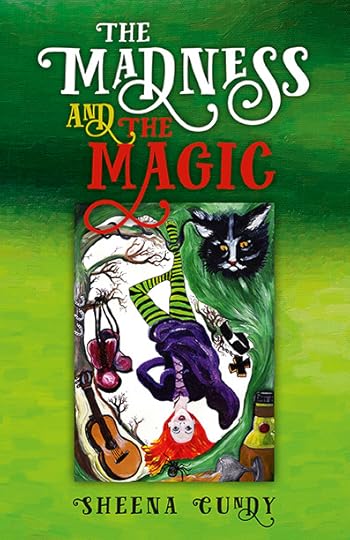 Not chick lit, but witch lit. Yep, it’s a genre now, and well worth investigating. My first foray into reading witch lit isThe Madness and the Magicby Sheena Cundy, which turns out to be a delightful read.First of all, it’s not fantasy. It’s the real world, but with magic. And Tarot cards. And tipples of brandy. And hot flashes—lots of hot flashes!The action centers around a trio of women (a mother-daughter pair, Minerva and Ronnie, and the mother’s best friend Isis) in a village in Britain. They face the usual round of modern-day problems—family, relationships, growing older—with humor and a touch of magic. There’s a Terry Pratchett-esque feel to the story, the kind of absurdity we find when we have to either laugh or cry and we choose to laugh. But there’s depth underneath the joking, and that’s what makes The Madness and the Magic really stand out for me. It’s a funny story but it’s real, too.And the magic is real. I find that quite refreshing, in a world that relegates anything magical to the Fantasy section of the bookstore, when we Pagans know quite well it’s anything but fantasy, even if all we're doing is turning over Tarot cards. But lest we take ourselves too seriously, Minerva, Rhiannon and Isis are there to remind us that sooner or later we’re going to say something we shouldn’t, or do something we shouldn’t, or (heaven forbid) pee ourselves while the vicar’s standing right there. And when that happens, we’d bloody well better laugh if we want to survive.This is a fun read but it’s not fluff. It’s quick but it won’t be a waste of your time. And yes, I do recommend it. Go get yourself a copy and join the ladies in their world of madness and magic.
Not chick lit, but witch lit. Yep, it’s a genre now, and well worth investigating. My first foray into reading witch lit isThe Madness and the Magicby Sheena Cundy, which turns out to be a delightful read.First of all, it’s not fantasy. It’s the real world, but with magic. And Tarot cards. And tipples of brandy. And hot flashes—lots of hot flashes!The action centers around a trio of women (a mother-daughter pair, Minerva and Ronnie, and the mother’s best friend Isis) in a village in Britain. They face the usual round of modern-day problems—family, relationships, growing older—with humor and a touch of magic. There’s a Terry Pratchett-esque feel to the story, the kind of absurdity we find when we have to either laugh or cry and we choose to laugh. But there’s depth underneath the joking, and that’s what makes The Madness and the Magic really stand out for me. It’s a funny story but it’s real, too.And the magic is real. I find that quite refreshing, in a world that relegates anything magical to the Fantasy section of the bookstore, when we Pagans know quite well it’s anything but fantasy, even if all we're doing is turning over Tarot cards. But lest we take ourselves too seriously, Minerva, Rhiannon and Isis are there to remind us that sooner or later we’re going to say something we shouldn’t, or do something we shouldn’t, or (heaven forbid) pee ourselves while the vicar’s standing right there. And when that happens, we’d bloody well better laugh if we want to survive.This is a fun read but it’s not fluff. It’s quick but it won’t be a waste of your time. And yes, I do recommend it. Go get yourself a copy and join the ladies in their world of madness and magic.
Published on August 10, 2016 04:50
July 27, 2016
Writing All the Ideas
 I've written a lot of books and I'm still writing. People often ask me where I get the ideas for my fiction and non-fiction; the implication is that ideas are hard to come by. I can tell you, the reality is that ideas spring up like mushrooms after a rainstorm. They're everywhere. A snippet of overheard conversation. A photo on a billboard. A personal life situation. I've even written books on request - that's what happened withLabrys and Horns, which myMinoan spirituality groupasked me to write as a follow-up toAriadne's Thread.For many writers, including me, coming up with ideas isn't the problem. I have a whole file drawer full of book ideas - novels, non-fiction, you name it. The problem is finding the time and the focus to figure out which of those ideas will turn into the best books.Which concepts can I actually flesh out into a full-length story?Which subjects can I dig up enough interesting information about to create a whole book?And, of course, the biggest problem for me:Which one should I tackle first?I get the feeling that I'm not very different from other creative people. Ideas pop into my head constantly throughout the day. Inspiration is everywhere. The challenge is to sort through the flash and sparkle of all the great ideas to find the ones I can actually turn into books that people will want to read.Once I've made that decision, which is hard enough, the next step is even harder: Actually sitting down and turning that idea into a book. This is the reason behind all those unfinished manuscripts in people's desk drawers all over the world.It ain't easy.It's actually very hard work, but most people don't realize that until they're hip-deep in a manuscript with no way out. It takes many hours and lots of labor and dedication to turn an idea into a book. It doesn't matter whether you're writing romance or horror or self-help or something else entirely. It's work.But for those of us who feel compelled to write, who can't imagine a life that doesn't involve putting words together into bigger and bigger bunches until we finally have a book, it's a labor of love.Do you have an idea for a book? I bet you have more than one idea. That's usually how it works. Hang onto those ideas. But even more important: Do something with them. Pick one - your favorite, the wackiest one, the one your best friend likes, whatever. Pick one and run with it. Write that book.No one else is going to write it for you.
I've written a lot of books and I'm still writing. People often ask me where I get the ideas for my fiction and non-fiction; the implication is that ideas are hard to come by. I can tell you, the reality is that ideas spring up like mushrooms after a rainstorm. They're everywhere. A snippet of overheard conversation. A photo on a billboard. A personal life situation. I've even written books on request - that's what happened withLabrys and Horns, which myMinoan spirituality groupasked me to write as a follow-up toAriadne's Thread.For many writers, including me, coming up with ideas isn't the problem. I have a whole file drawer full of book ideas - novels, non-fiction, you name it. The problem is finding the time and the focus to figure out which of those ideas will turn into the best books.Which concepts can I actually flesh out into a full-length story?Which subjects can I dig up enough interesting information about to create a whole book?And, of course, the biggest problem for me:Which one should I tackle first?I get the feeling that I'm not very different from other creative people. Ideas pop into my head constantly throughout the day. Inspiration is everywhere. The challenge is to sort through the flash and sparkle of all the great ideas to find the ones I can actually turn into books that people will want to read.Once I've made that decision, which is hard enough, the next step is even harder: Actually sitting down and turning that idea into a book. This is the reason behind all those unfinished manuscripts in people's desk drawers all over the world.It ain't easy.It's actually very hard work, but most people don't realize that until they're hip-deep in a manuscript with no way out. It takes many hours and lots of labor and dedication to turn an idea into a book. It doesn't matter whether you're writing romance or horror or self-help or something else entirely. It's work.But for those of us who feel compelled to write, who can't imagine a life that doesn't involve putting words together into bigger and bigger bunches until we finally have a book, it's a labor of love.Do you have an idea for a book? I bet you have more than one idea. That's usually how it works. Hang onto those ideas. But even more important: Do something with them. Pick one - your favorite, the wackiest one, the one your best friend likes, whatever. Pick one and run with it. Write that book.No one else is going to write it for you.
Published on July 27, 2016 04:44
July 20, 2016
Journeying to the Realm of the Dead
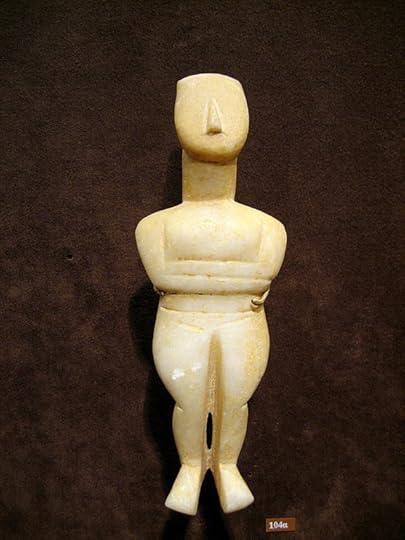 This week on theMinoan Path blogI'm exploring another ritual posture from ancient Crete. I've discovered some interesting aspects of this one that are different from what other people have experienced, all because I stopped to think about how these figurines were meant to be positioned (hint: It's not upright like the photo shows). To find out what I discovered, hop on over to the blog post:Minoan Ecstatic Postures: The Realm of the DeadIf you're interested in Minoan spirituality, both ancient and modern, please join the conversation in our welcoming community atAriadne's Tribeon Facebook.In the name of the bee,And of the butterfly,And of the breeze, amen.
This week on theMinoan Path blogI'm exploring another ritual posture from ancient Crete. I've discovered some interesting aspects of this one that are different from what other people have experienced, all because I stopped to think about how these figurines were meant to be positioned (hint: It's not upright like the photo shows). To find out what I discovered, hop on over to the blog post:Minoan Ecstatic Postures: The Realm of the DeadIf you're interested in Minoan spirituality, both ancient and modern, please join the conversation in our welcoming community atAriadne's Tribeon Facebook.In the name of the bee,And of the butterfly,And of the breeze, amen.
Published on July 20, 2016 04:39
July 13, 2016
More Minoan Ecstatic Postures
 This week on theMinoan Path BlogI'm exploring some more ritual postures that the ancient Minoans used for journeying to their goddesses and gods. Most modern Pagans are familiar with ritual gestures - the Goddess Pose from Wicca, for instance - but ecstatic postures are a little different. They're meant to be held for an extended period of time to help guide a trance journey. I first got interested in these poses after reading Belinda Gore's awesome bookEcstatic Body Posturesand discovering that some of the poses her group explored were from ancient Crete.This time I worked with a pose that I call Shading the Eyes. To find out where it took me and what I experienced, hop on over to this blog post:Minoan Ecstatic Postures: Shading the EyesIf you'd like to join the conversation about Modern Minoan Paganism, you'll find our welcoming community on Facebook:Ariadne's Tribe.In the name of the bee,And of the butterfly,And of the breeze, amen.
This week on theMinoan Path BlogI'm exploring some more ritual postures that the ancient Minoans used for journeying to their goddesses and gods. Most modern Pagans are familiar with ritual gestures - the Goddess Pose from Wicca, for instance - but ecstatic postures are a little different. They're meant to be held for an extended period of time to help guide a trance journey. I first got interested in these poses after reading Belinda Gore's awesome bookEcstatic Body Posturesand discovering that some of the poses her group explored were from ancient Crete.This time I worked with a pose that I call Shading the Eyes. To find out where it took me and what I experienced, hop on over to this blog post:Minoan Ecstatic Postures: Shading the EyesIf you'd like to join the conversation about Modern Minoan Paganism, you'll find our welcoming community on Facebook:Ariadne's Tribe.In the name of the bee,And of the butterfly,And of the breeze, amen.
Published on July 13, 2016 05:40
July 6, 2016
Minoan Ecstatic Postures: Beginning the Adventure
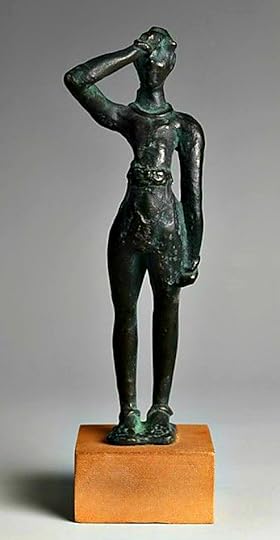 Archaeologists have found lots of Minoan figurines that show people in odd poses, with their arms in strange positions. It turns out, these are ritual postures used not just to show reverence but also to attain altered states of consciousness. This week on the Minoan Path Blog I'm exploring the most well-known of these postures, called the Minoan salute:Minoan Ecstatic Postures: Beginning the AdventureIn upcoming weeks I'll share my experiences with other poses found in Minoan art. I hope you'll join me on this journey.If you'd like to join the conversation about Modern Minoan Paganism, please head on over to our welcoming community atAriadne's Tribeon Facebook.In the name of the bee,And of the butterfly,And of the breeze, Amen.
Archaeologists have found lots of Minoan figurines that show people in odd poses, with their arms in strange positions. It turns out, these are ritual postures used not just to show reverence but also to attain altered states of consciousness. This week on the Minoan Path Blog I'm exploring the most well-known of these postures, called the Minoan salute:Minoan Ecstatic Postures: Beginning the AdventureIn upcoming weeks I'll share my experiences with other poses found in Minoan art. I hope you'll join me on this journey.If you'd like to join the conversation about Modern Minoan Paganism, please head on over to our welcoming community atAriadne's Tribeon Facebook.In the name of the bee,And of the butterfly,And of the breeze, Amen.
Published on July 06, 2016 04:42
June 29, 2016
Hold onto the Ancestors
These are trying times. The economy has been horrible for a while now. My British friends are struggling between fear and hope after the Brexit vote. American politics are heating up in an ugly way as we near the 2016 presidential election. The climate is causing problems around the globe. Peace seems very far away.What on earth can we hold onto, to maintain a little sanity in a world gone mad?The ancestors.Those are my great-grandparents, Eliza Smith Douglass and Frederick Harmon Douglass, at

Published on June 29, 2016 04:30
June 23, 2016
Book Review: The Awen Alone
I've just finished a lovely book. The Awen Alone: Walking the Path of the Solitary Druid is part of the Pagan Portals series, shortish introductions to a variety of pagan subjects. For such a brief book, this one is certainly packed full. Joanna van der Hoeven has done an excellent job of creating a useful reference that's good for dipping your toes in but also promises to be worth referring back to farther along the line.For starters, it has one of the best introductions to Druidry that I've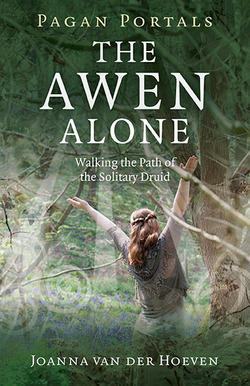

Published on June 23, 2016 10:31



